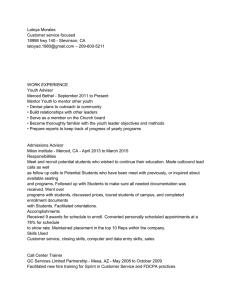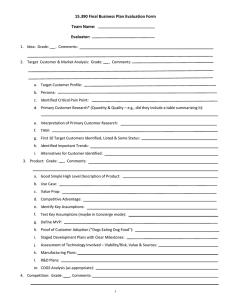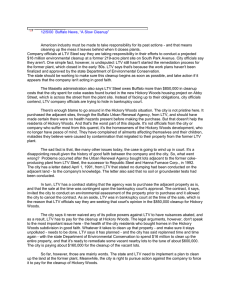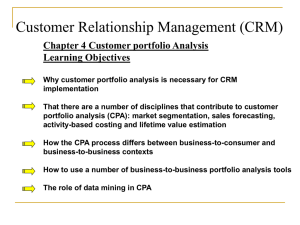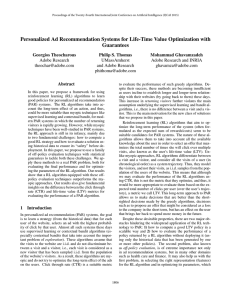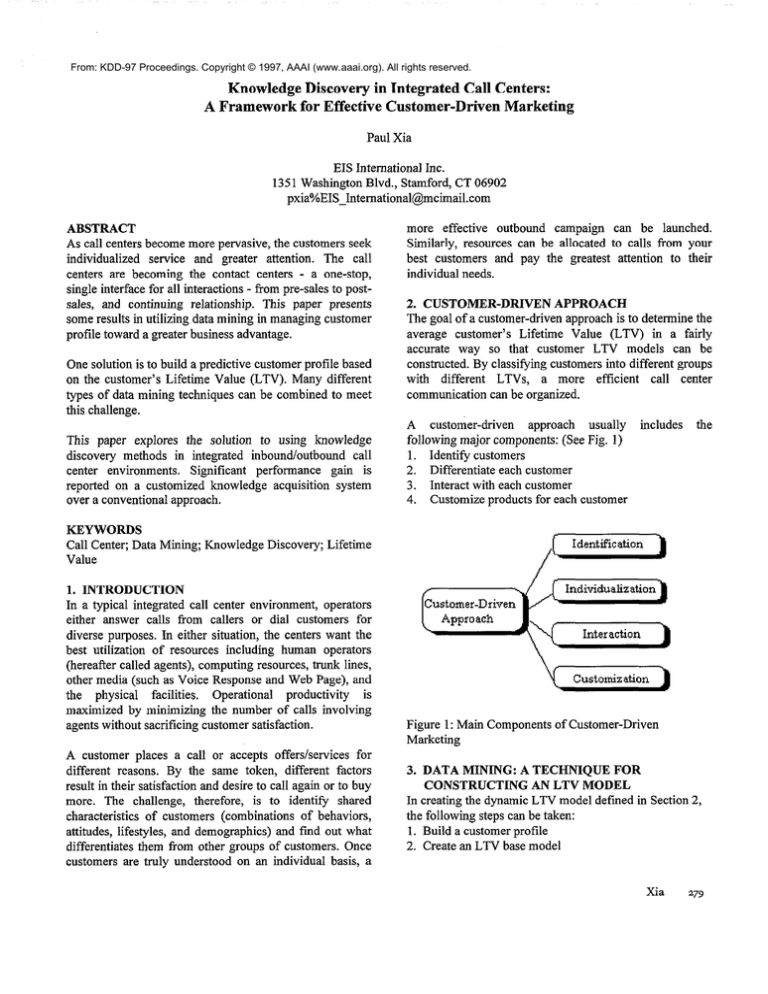
From: KDD-97 Proceedings. Copyright © 1997, AAAI (www.aaai.org). All rights reserved.
Knowledge Discovery in Integrated Call Centers:
A Framework for Effective Customer-Driven Marketing
Paul Xia
EIS International Inc.
1351 WashingtonBlvd., Stamford, CT 06902
pxia%EIS~Intemational@mcimail.com
ABSTRACT
As call centersbecomemore pervasive,the customersseek
individualized service and greater attention. The call
centers are becoming the contact centers - a one-stop,
single interfacefor all interactions- from pre-salesto postsales, and continuing relationship. This paper presents
someresults in utilizing data mining in managingcustomer
profile toward a greaterbusinessadvantage.
One solution is to build a predictive customerprofile based
on the customer’s Lifetime Value (LTV). Many different
types of data mining techniquescan be combined to meet
this challenge.
This paper explores the solution to using knowledge
discovery methods in integrated inbound/outbound call
center environments. Significant performance gain is
reported on a customized knowledge acquisition system
over a conventionalapproach.
more effective outbound campaign can be launched.
Similarly, resourcescan be allocated to calls from your
best customers and pay the greatest attention to their
individual needs.
2. CUSTOMER-DRIVEN APPROACH
The goal of a customer-drivenapproachis to determinethe
average customer’s Lifetime Value (LTV) in a fairly
accurate way so that customer LTV models can be
constructed.By classifying customersinto different groups
with different LTVs, a more efficient call center
communicationcan be organized.
A customer-driven approach usually includes the
following major components:(SeeFig. 1)
1. Identify customers
2. Differentiate eachcustomer
3. Interact with eachcustomer
4. Customizeproducts for eachcustomer
KEYWORDS
Call Center; Data Mining; Knowledge Discovery; Lifetime
Value
1. INTRODUCTION
In a typical integrated call center environment, operators
either answer calls from callers or dial customers for
diverse purposes.In either situation, the centers want the
best utilization of resources including human operators
(hereaftercalled agents),computing resources,trunk lines,
other media (such as Voice Responseand Web Page), and
the physical facilities. Operational productivity is
maximized by minimizing the number of calls involving
agentswithout sacrificing customersatisfaction.
A customer places a call or accepts offers/services for
,-l:ffm.Pnt
rl;ffc.mnf
fc.,+n+o
IULZLVIJ
UIII~IG‘
ILronn.-.lrn
l~cL3”llJ.Rrr
YJ the s&me token) CIIII~IVIIC
result in their satisfaction and desireto call again or to buy
more. The challenge, therefore, is to identify shared
characteristicsof customers (combinations of behaviors,
attitudes, lifestyles, and demographics)and find out what
differentiates them fi-om other groups of customers.Once
customers are truly understood on an individual basis, a
Figure 1: Main Componentsof Customer-Driven
Marketing
CONSTRUCTING AN LTV MODEL
In creatingthe dynamic LTV model defined in Section2,
the following stepscan be taken:
1. Build a customerprofile
2. Createan LTV basemodel
Xia
279
3. Create an In/Outbound call campaign with forecasting
capacity
4. Create an In/Outbound call survey with learning
capacity
5. Identify warehousedata and external supplements
6. Repeatstep (3), (4) (5) to generatea more complex and
accurateLTV model
The following sub sectionsdiscusshow data mining
technology can be applied in each step.
3.1 Build a Customer Profile
Customer profile building is a process of segmentation
according to definite types of customer behavior.
If similarity measures and segmentation examples are
known, clustering can be achieved with techniques such as
k-nearest neighbors. If no classification is known, but
some similarity exists between customers, clusters are
formed maximizing the degree of similarity between
callers in the same partition. Depending upon how and
when the new classification request has been made,
Aiffcwent
m-e-wnnrhec
UlllVl
“#A& Uyyn
“UVll”U
ran
“UIl
he
“Y
V(Aj) = C S(Mk, Aj >
The computation in (2) is facilitated by a judicious choice
of a vector comprising of elements(Mk, Aj ).
Customer value can be quantified in various levels and in
various time intervals. The simplest characterizationis
high and low in value, and time as presentand future.
3.3 Create an Inbound/Outbound Call Campaign with
Forecasting Capacity
Using a caller’s personal profile, effective caller
segmentationcan be created.
Induction trees are being used to extract prediction rules
for the future based on past data, in order to find groups of
people with high similarity in an LTV model.
When an inbound/outbound call succeeds,if the product or
service is accepted, basket analysis would be conducted,
nnrl nther
..&&..
“I1.v.
taken
CUI.VI..
(2)
k
slccnrint~rl
..yy”“IyI~~
mmchanrlice
.1&W.
“.L.+.I..IYI
itmnc
.“-....,
cwwmtwl
b-AA-‘
“‘-..
firm
;t
are also offered.
For building the primary customer segmentation,or if new
customers have been acquired from external sources, the
global similarity could be maximized with Genetic
Algorithm (GA).
The similarity in our interactive KDD system is predefined by the representationbased on a customer’s profile
and a call center’s activities such as telemarketing,
donation, collection, reservation, and help-desk.
3.2 Create an LTV Base Model
The most important step in the LTV modeling processis to
build time seriesfunctions that measure some properties of
partitions as functions of certain parameters of the
partition.
Suppose a time period A is given, and supposeA can be
divided into disjointed set of time periods called Aj. One
can define a function V(Aj) that measuressome property
for that time period. Then one can build a global function
V(A) as the sum of V(Aj) to representLTV:
LTV = V(A) = C V(Aj)
(1)
Since a customer’s LTV is meaningful only when it is
associatedwith a particular service or product, and one can
define a function S(Mk, Aj) to correspond to the value of
the service/product Mk in time period Aj for a particular
customer,V(Aj) can be expressedas:
280
KDD-97
3.4 Create an Inbound/Outbound Call Survey with
Learning Capacity
Becauseof the contact interface (web or/and phone) and its
nature (such as quick response, single/multiple
selection(s), sophistication of users, etc.), the selected data
mining technology must be:
fast
. understandable
. easily translatedto a relational database
. user friendly
A modified C4.5-like algorithm was developed to meet
above criteria for supervisedclassification.
l
If an instance can not be found in real time, unsupervised
clustering is involved and more constraints are imposed.
3.5 Identify External/Warehouse Data Supplements
Our interactive KDD systemprovides data warehouseand
host interface and a set of utilities for the noise handling.
4. INBOUND/OUTBOUND CALL PROCESSING
MODEL
The following figure (Fig. 2) demonstratessimplified call
processeswith knowledge learning capacities.
By talking with the callers via the telephone, IVR, and/or
the Internet, the system learns a lot about their individual
needs, satisfaction, demographic and psychological
characteristics.All the information from callers is analyzed
on fly. The key information regarding what a customer
says and wants can be fed into a central database,and a
more accurateLTV model can be constructed.
The databaselearning system presented above provides a
mechanismfor:
. Translation of processed databaseinformation (from
data warehouseand external data sources) into a form
suitable for use by discovery and prediction engines
. Extraction of rules and other knowledge from the
database, which is stored as meta objects in a
knowledge base
Dynamic agent scripts created on the fly to understand
and solve caller’s needs
l
Figure 2: Call Processwith Knowledge Learning
5. MODEL SYSTEM IMPLEMENTATION
5.1 Description
The following flowchart (Fig. 3) demonstratesthe basic
information flow of a call center Knowledge Acquisition
system.
5.2 Implementation
The knowledge base including mined data is stored and
constructedas meta objects under ODBMS for:
performance gain
. intelligent and efficient storage
. flexibility in constraint processingfor various types of
data
better representationof the regular knowledge of
attributes
l
l
5.3 Performance
The speed of finding similarity and rules is critical for
caller access. Many approaches are used to meet this
timing requirement. For instance, the modified genetic
algorithms used as a filter to reduce the number of features
neededto describe an instance.
Figure 3: Simplified Interactive Learning DatabaseSystem
VRU: Voice Response Unit
Scripts: Information Container
K.A.Server: Knowledge Acquisition Server
DE: Discovery Engine
PE: Predictive Engine
DP Utility: Data Processing Utility including
transformation and aggregation
VLDB: Very Large DB, Warehouse Data
E. D: External Data
KB: Knowledge Base/Mine Data
data segmentation,
5.4 Data/Knowledge Representation
The knowledge representationis createdby a dynamic
memory model which organizes similar casesunder
general categories,which includes:
A typical casefor that time period for the model LTV
Common features
Contributing or discriminating features
Relevanceweight associatedwith contributing or
discriminating features
COMPARISON OF KDD MODEL TO
CONVENTIONAL APPROACHES
Two data sets were used for model development and
testing: a small demographics data set of approximately
100 MB containing 600 attributes on 35,000 callers and
buying-pattern information, and a larger demographics
Xia
281
An+”
U(IL(I
n.-.+ r.c
DGL “1
“....“,..,:-,.+,I..
app‘“nllllarcly
1 q
1.L
OD
“La
,r.“.+,:,:..,
L”lllallllll~
?n
I”
. ..+4.“.t...*,,
aLL,,“ULG;b
on 3,000,OOOcallers. Data were obtained from many
sources.Based on simulation and some field tests, we
found significant performancegain as depictedin F igures
4 and 5:
The salesclose rate improved dramaticallyby at least
30%. The amount of improvement dependedupon
how well the caller’s needs were addressed,proper
products,etc.
Dramatic reduction of returned merchandise.It was
achievedby tailoring products/servicesmore tightly
into each customer’sunique needs as well as early
fraud detection.
Because of the overall improvement of customer
satisfaction,caller/prospectscomeback far more often
than before.
The customer’s satisfaction has been enhanced_hv
1 5 % or more due to the understandingof their
diversified needsand the use of individualizedscripts
which providesmuch better service.
Since customer profiles and trends were measured
dynamically, the agent can cross-sell products/
services to customers.Therefore, not only did the
revenueper sale increaseby 150%, but also the cost
per leadwas down by 7 0 % or more.
The application of interactive-knowledgediscovery to a
call center environment is a valuable approach. It
maximizes agent productivity while meeting desired
performancerequirements.It beats the traditional m ining
process by over 3 0 % or more in every measure. Its
flexibility in adjustingto any customer’scondition change
makes it ideally suited to dynamic conditions in both
inboundand outboundcalling.
Much can be gamed by positioning a call center as an
interactivem e d ium. A businessentity can acquirecritical
customerknowledge,recognizeconsumers’
diverseneeds,
respond to these needs individually and serve them.
Service itself can now be variable, determined by a
current and future profitability, which is combined with
company’s goals for increasing customer acquisition,
referrals,repeatpurchasesand cross-sales.
8. BIBLIOGRAPHY
[l] M ichie, D. Spiegelhalter and Taylor, Machine
Learning, Neural and Statistical Classification, Ellis
Horwood, 1994
[2lW ~ 4
U., Piatetsky-Shapiro, Smyth, and
Uthurusamy,Advancesin Knowledge Discovery and
Data M ining, M IT Press,1996
[3] LawerenceDavis, Handbook of Genetic Algorithms,
Van NostrandReinhold, 1991
Lf41J Ouinlan.
x- --------I J, Rej
Repeat Calls
fnr
---
Ma&ice
[5] Don Peppers,Martha Rogers,Enterprise One To
One, Doubleday,1997
Prospect Clwe
Marchandke
R&urn
0
Fimre
- -a---
Cd,51 Prwramn
- - -o- -----
Learning, Morgan Kaufmann, 1992
IO
20
4: RefilmlC.!nelReneat r---
30
40
Rnainess
---------
50
Cgqcris~n
En%
[6] Proceedingsof the 1” International ConferenceO n
Knowledge Discovery & Data M ining, AAAI Press,
1995
[7] Proceedingsof the ZndInternational ConferenceO n
Knowledge Discovery & Data M ining, AAAI Press,
1996
Satisfaction
Rmnue
lT:-.-r Igulc;
282
z. I3 -..--..-/
~~~e~,(ll~c:~~~..c:~..
.J. RCYt;,,Ut;,~“btS,3SIL,sISLCt,“I,
KDD-97
~-----:^-L”llqJat
,S”,,
l &uv+ht
Amm+an
- ” ~~_... ml
v--l.,QQ7 ------_.--.
A ..n~ra~:nr;
C--t
z*YL.“I4UYI”AI
I”1 NA-tin-‘
CIIII;,~
Intehigence(www.aaai.org).Ah rights reserved.


